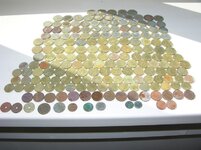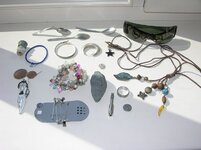woody50
Bronze Member
- Jun 21, 2007
- 1,881
- 206
- Detector(s) used
- XP Deus
- Primary Interest:
- All Treasure Hunting
Finally got back to the beach, its been several years ago since I last went there (with BioProfessor). Not crazy about finding new coins really, and you don't find anything else there on the Dutch beaches, in our area anyway. The reason for going was to try out my new detector, try some adjustments and seeing what or how much I could find.
Before I have always used my White's Pulse Induction (PI) machine on the beaches, and before the Euro I found quite a few Dutch coins with it. One of the reasons was that because the 5 gulden pieces (about 2.3 euros) were thick heavy coins, people losing one back then would look in the first inches and give up the search. These coins being heavy dug in deep. I found many with the PI at about 12 inches, they gave a great clean signal. Many were slightly or more corroded which showed that they were in the ground for quite some time, thus not found by other detectorists.
Back then I went to the beach after a day or two of hot weather. Normally I found about 200-250 guldens (94-114 euros) each time I went, searching the night and into the next morning 2300 to 1000 (at 10am the beach got too busy), then taking a break until the crowd thinned out, and then searching again from about 1500 to 1700. My biggest reason for doing that (searching the beach) was to save up money for my son's collage (bachelors degree), and that worked. I had saved up about 16,000 guldens (€ 7300) over a number of years, that put him through collage (with a bit of cash support from Dad).
Anyway I always did my beach searching with the PI detector, it worked just great until the Euro came around. The Euro coins are terrible coins, many contain iron, so they crack and pop and make funny noises, where the old gulden coins gave a clean crisp signal. I still find some nowadays just as clean as when they were made. Well since the introduction of the Euro I have done some beach searching for about three times. The best time I found about 30 euros (and a few dutch gulden coins). So just stopped going.
Now I wanted to get to know this detector, so after some learning sessions in the clay soil here I decided I wanted to see what it would do on the beach. This time I took the train from where I live to the beach, great trip and the train station is direct on the beach. Step out, walk about 100 meters and you are there, get your detector out and search. No traffic jams and you don't have to pay for parking either. (Also, since I am retired and have a train pass, it does not cost me anything either!). So got there, started to search. It was about 0900 and cloudy but no rain. There was almost no one on the beach. After a few minutes I saw the one and only other detectorist, he was going back home, he had not found much he said.
So searched from 0900 to 1830 about 9 1/2 hours, constant, only stopping to drink some water. Since I have not used a meter detector for many many years I had to get used to it again. So I dug every signal for about a hour, watching which number showed up and looking at what the finds were. These tests gave me a indication on what range of numbers I should look for. I was only really looking for coins to see what the detector could do. Then moving on and only digging the good signals within the ranges, I was only digging silver, coins, and copper and no iron, tinfoil or other junk. I though about notching the junk out, but I did not know how to do that (yet). I would never use notching for normal searching, you can miss too much.
Anyway found this time € 98.06 ($ 124), a total of 175 coins, plus other things (see the photos). Not bad at all, that's back at the level I was at with the PI. The biggest problem was that the PI had problems with iron cores I guess (you cannot discriminate with PI), this detector did not have that problem.
For my Euro friends, I broke down the numbers, I wanted to see also which lands they came from. It was thought in Holland at the begin of the Euro that the Germany coins would be found in a much much greater number than others, due to the large number of people there and the good economy. Only the high values shown... The other coins were old dutch coins, 3x a casino coin, 1 french frank, and even 2 English coins....
GE SP BE NL FR IT AU GR IR FI PO
€ 2 (16x) 7 0 3 1 3 1 1 0 0 0 0
€ 1 (39x) 13 6 3 4 6 5 2 1 0 0 0
€ 50 cent (28x) 8 1 5 8 4 1 0 1 0 0 0
€ 20 cent (42x) 16 1 9 5 5 3 1 0 1 1 0
€ 10 cent (38x) 13 1 4 12 3 3 1 0 0 0 1
Sure looks like to me that the Dutch sure are thrifty (or cheap, conserving, scrimpy, chintzy or any other word you can think of) they lose only the small coins! It was a great day, and although my legs are a bit tired today might even do it again!
Before I have always used my White's Pulse Induction (PI) machine on the beaches, and before the Euro I found quite a few Dutch coins with it. One of the reasons was that because the 5 gulden pieces (about 2.3 euros) were thick heavy coins, people losing one back then would look in the first inches and give up the search. These coins being heavy dug in deep. I found many with the PI at about 12 inches, they gave a great clean signal. Many were slightly or more corroded which showed that they were in the ground for quite some time, thus not found by other detectorists.
Back then I went to the beach after a day or two of hot weather. Normally I found about 200-250 guldens (94-114 euros) each time I went, searching the night and into the next morning 2300 to 1000 (at 10am the beach got too busy), then taking a break until the crowd thinned out, and then searching again from about 1500 to 1700. My biggest reason for doing that (searching the beach) was to save up money for my son's collage (bachelors degree), and that worked. I had saved up about 16,000 guldens (€ 7300) over a number of years, that put him through collage (with a bit of cash support from Dad).
Anyway I always did my beach searching with the PI detector, it worked just great until the Euro came around. The Euro coins are terrible coins, many contain iron, so they crack and pop and make funny noises, where the old gulden coins gave a clean crisp signal. I still find some nowadays just as clean as when they were made. Well since the introduction of the Euro I have done some beach searching for about three times. The best time I found about 30 euros (and a few dutch gulden coins). So just stopped going.
Now I wanted to get to know this detector, so after some learning sessions in the clay soil here I decided I wanted to see what it would do on the beach. This time I took the train from where I live to the beach, great trip and the train station is direct on the beach. Step out, walk about 100 meters and you are there, get your detector out and search. No traffic jams and you don't have to pay for parking either. (Also, since I am retired and have a train pass, it does not cost me anything either!). So got there, started to search. It was about 0900 and cloudy but no rain. There was almost no one on the beach. After a few minutes I saw the one and only other detectorist, he was going back home, he had not found much he said.
So searched from 0900 to 1830 about 9 1/2 hours, constant, only stopping to drink some water. Since I have not used a meter detector for many many years I had to get used to it again. So I dug every signal for about a hour, watching which number showed up and looking at what the finds were. These tests gave me a indication on what range of numbers I should look for. I was only really looking for coins to see what the detector could do. Then moving on and only digging the good signals within the ranges, I was only digging silver, coins, and copper and no iron, tinfoil or other junk. I though about notching the junk out, but I did not know how to do that (yet). I would never use notching for normal searching, you can miss too much.
Anyway found this time € 98.06 ($ 124), a total of 175 coins, plus other things (see the photos). Not bad at all, that's back at the level I was at with the PI. The biggest problem was that the PI had problems with iron cores I guess (you cannot discriminate with PI), this detector did not have that problem.
For my Euro friends, I broke down the numbers, I wanted to see also which lands they came from. It was thought in Holland at the begin of the Euro that the Germany coins would be found in a much much greater number than others, due to the large number of people there and the good economy. Only the high values shown... The other coins were old dutch coins, 3x a casino coin, 1 french frank, and even 2 English coins....
GE SP BE NL FR IT AU GR IR FI PO
€ 2 (16x) 7 0 3 1 3 1 1 0 0 0 0
€ 1 (39x) 13 6 3 4 6 5 2 1 0 0 0
€ 50 cent (28x) 8 1 5 8 4 1 0 1 0 0 0
€ 20 cent (42x) 16 1 9 5 5 3 1 0 1 1 0
€ 10 cent (38x) 13 1 4 12 3 3 1 0 0 0 1
Sure looks like to me that the Dutch sure are thrifty (or cheap, conserving, scrimpy, chintzy or any other word you can think of) they lose only the small coins! It was a great day, and although my legs are a bit tired today might even do it again!
Attachments
Upvote
0






 congrats woody50
congrats woody50 

